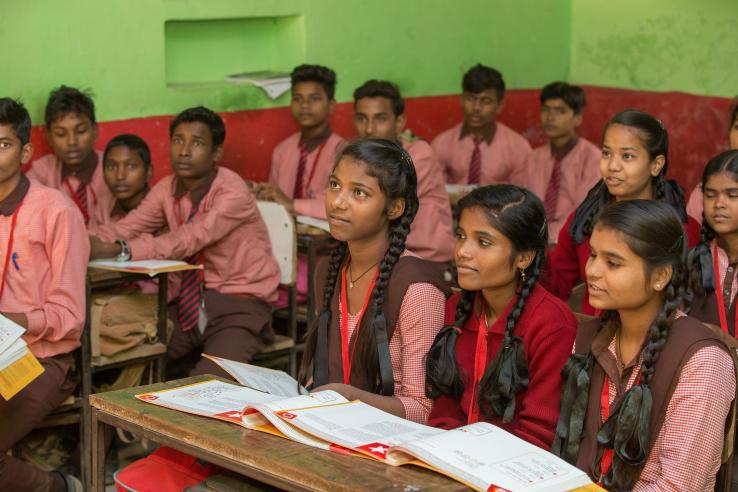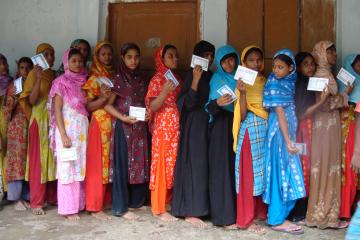
Gender inequality: What really needs to change?

Policies and programmes must change restrictive gender norms in order to meaningfully impact the lives of women and girls.
This post was originally published on India Development Review on July 29, 2021.
In many societies, women’s choices around education, marriage, employment, and childbearing are severely limited and often prescriptive. Within homes, schools, work, and public places, critical life decisions are underpinned by social and gender norms that contribute to a widespread acceptance of discriminatory practices against women. Broadly understood, gender norms are ‘informal rules that impose expectations about behaviour that are dependent on gender’. Not only do these define socially acceptable behaviour, but they also have the power to influence expectations for men and women—directly affecting their choices, freedoms, and capabilities.
Restrictive norms which fuel gender biases have been examined in social science research for the role they play in obstructing gender equality across multiple dimensions of politics, education, economics, and physical integrity ie. freedom from intimate partner violence and access to reproductive rights. Researchers also find that gender gaps favouring men over women are wider in developing countries.
An important consequence of unequal gender norms is that they have the potential to minimise the positive impacts of a range of programmes designed to improve women’s health, educational attainment, employment, and financial inclusion, among others.
Evidence from randomised evaluations suggests that to make meaningful changes in the fight against gender inequality, stakeholders must directly intervene to change biased gender norms in policy and programme design.
Why early marriage among girls persists
Norms favouring the early marriage of girls have resulted in its widespread practice and are correlated with negative health and education outcomes for women. One possible approach to successfully curb early marriage practices is accounting for the influence of parents on marital decisions.
A study in rural Bangladesh tested whether providing conditional incentives for parents to delay their daughters’ marriage, empowering adolescents, or a combined approach could reduce child marriage, teenage childbearing, and increase educational attainment among adolescent girls. Girls whose families received conditional incentives (such as cooking oil), were 23 percent less likely to marry before the age of 18 and 13 percent less likely to have children during their teenage years, relative to girls in communities without any programming. In comparison, while the adolescent empowerment programme—providing training in life skills, reproductive health, and financial literacy—had a positive impact on girls’ education, it failed to delay the age of marriage and childbearing.
The limited impact of the adolescent empowerment programme on the age of marriage suggests that parental preferences and underlying gender norms are still relevant factors in marital decisions. Programmes that seek to end child marriage must leverage parents’ influence while approaches to empower adolescent girls may work better in contexts where young people have more control over their marriage choices.
Gender norms and women’s entrepreneurship
Social acceptance of men as the financial decision-makers tends to limit women’s control over their own earnings.
A randomised evaluation in India, tested the impact of easing financial constraints, by providing loans with a grace period, to female micro-entrepreneurs in two types of households: ones in which women were the only entrepreneurs and those in which other members (typically male) also had a business. In households with multiple business owners, providing a loan with a grace period was able to increase business profits at the household level by around 45 percent. This, however, had no effect on female-run businesses. By contrast, when a woman was the sole entrepreneur in her household, the grace period contract increased her business profits by as much as 75 percent.
These results—also found in countries such as Ghana and Sri Lanka—suggest that poor financial returns to female entrepreneurs occurred because women’s financial resources were often redirected to their husbands’ businesses. Similarly, restrictive gender norms can also limit the impacts of skilling or financial access programmes. A study in Pakistan found that start-up loans and business training had limited success for female-owned enterprises, possibly due to expectations that women should only operate businesses from home and have minimal interactions with people outside the household.
Misperceptions of norms around women’s work
Certain ideas around how women are expected to behave may persist because people wrongly perceive and conform to regressive social norms. For instance, men might be publicly opposed to their sisters or wives driving independently, even if they privately believe otherwise. This is because they believe that society expects them to oppose it, and as a result end up acting against their own views. Such individual misperceptions can be damaging—particularly when the community or peer groups have progressive views.
In Saudi Arabia, a study found that while a majority of men privately supported women’s participation in the workforce, they tended to misjudge the level of support within the community. Around 72 percent of men in this study underestimated other participants’ overall support for female labour force participation. Moreover, the wives of participants who were informed about their peers’ favourable opinions regarding women’s work, were significantly more likely to have applied for and interviewed for a job outside the home.
Another potential approach to change husbands’ attitudes towards women’s employment is to increase women’s financial control, thereby increasing their bargaining and decision-making power within the home. A study in Madhya Pradesh found that women’s labour force participation and their husband’s support for their work increased among women who were provided with their own bank accounts, training on how to use them, and a direct deposit of their wages (earned through the Mahatma Gandhi National Rural Employment Guarantee Scheme or NREGA).
Affording women greater financial control allowed them to work more, have greater financial freedom, and express support for more progressive gender norms. Husbands were less likely to oppose women working for pay outside the home and less likely to perceive harsh social sanctions because their wives worked. In contrast, impacts were weaker when women did not receive bank account training or a direct wage deposit, indicating that financial knowledge and agency are needed to increase financial control.
Transforming gender norms early and effectively
Progressive policies can also target norms directly and be designed to change gendered attitudes and behaviours at an early age. Evidence suggests that increasing adolescent boys’ and girls’ exposure to gender-egalitarian curricula, can offer a viable and scalable pathway for changing norms.
A randomised evaluation in Haryana studied the impact of interactive classroom discussions about gender roles and gender discrimination, held over two and a half school years, on the gender attitudes, aspirations, and behaviours of adolescent girls and boys.
The programme, designed by the nonprofit Breakthrough, had a positive impact on both girls’ and boys’ gender attitudes and made them more supportive of gender equality. Students who initially held gender discriminatory attitudes changed their views to be more gender-equal in 16 percent of cases, with the largest impacts on attitudes towards women’s employment, education, and gender roles. The programme also led students to enact more gender-equitable behaviours, particularly among boys, who reported performing more household chores. Girls, however, did not report doing fewer chores. This suggests that boys are likely to have greater freedom to act on their gender-sensitisation education than female participants—underscoring the importance of sensitising boys early. Surveys also found that these positive effects on attitudes and behaviours were still present two years after the programme ended (when the students were, on average, 17 years old).
These promising results have also prompted the Punjab government to implement the gender sensitisation curriculum for students from Grades 6 to 8 across 4,500 public schools in the state.
By encouraging girls and boys to adopt more progressive gender roles, such programmes may have the potential to impact other phases of adolescents’ lives and set the stage for more positive life outcomes for women in the future. While the longer-term effects of this programme are yet to be measured, this programme may also have intergenerational effects in the future.
Making gender equality the norm
A vast majority of Indian women and girls have been living in conditions of low empowerment and agency, despite overall economic growth. Not only do deeply entrenched norms limit girls’ opportunities within and outside the home, but they can also undo the desired effects of programmes and policies designed to improve women’s lives.
However, programmes that aim to change norms—directly or indirectly—must also account for any unintended consequences that may arise due to altered power dynamics. For instance, economic interventions might be able to change power dynamics in a household by giving women more control within the family and result in more freedom of movement. But if men feel threatened by women’s changed status and role, particularly in contexts characterised by inequitable gender norms, these changes could lead to a backlash from them.
While norms can change over time as economies develop, communication technology becomes more widespread, and through education, role models and the media, stakeholders can also make concerted efforts to accelerate this process. Accounting for social norms in programme design and crucially, targeting gender inequality early and effectively has the potential to enact much-needed systemic change in the lives of women and girls in India.
Related Content

Enhancing Women’s Agency: Cross-Cutting Lessons From Experimental and Quasi-Experimental Studies in Low- and Middle-Income Countries

J-PAL South Asia launches partnership with Government of Punjab, India


